Technical Newsletter
Issue 24
Project Information
Name: Ramapo Cirque
Suffern, New York
Product: AB Collection
Size: 22,000 ft² (2,044 m²)
Engineer:
Allied Engineering Assoc. (Phase I)
Geotechnical Engineering Options (Phase II)
Contractor:
Earth Management (Phase I)
CONSERV Construction (Phase 2)
Allan Block Manufacturer:
Clayton Block
Edison, NJ
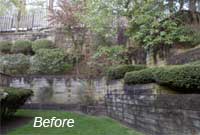
Old Timber Wall
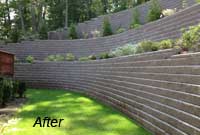
New Allan Block Retaining Wall
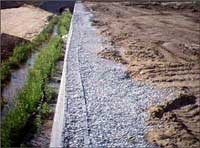
Overturning Retaining Wall
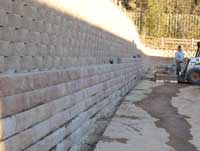
Renewing Retaining Wall with New Face & No-Fines Concrete
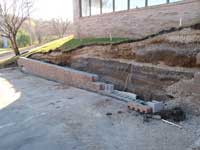
Replacing Retaining Walls
Can you use Recycled Concrete Aggregate as backfill?
As roads are being redone and buildings are being demolished, you see an increasing emphasis on recycling the concrete instead of filling up landfills. Most uses involve crushing the concrete to use the product as aggregate.
So the question is can this recycled concrete aggregate (RCA) be used as backfill material behind an Allan Block wall? The short answer is “No” unless you take the necessary design steps to manage the chemical properties associated with RCA. The reason is that the cement paste component of recycled concrete aggregate has substantial influence on the alkalinity within the aggregate. In fact, the pH levels have often exceeded 11. Keep in mind that 7 is neutral and anything over 11 is 10,000 times more alkaline than water.
Therefore, you will need to make sure the geogrid used can resist the elevated pH levels and maintain its integrity.
Contact Allan Block if you have any questions.
Rebuild, Renew, Replace
There are many ways to solve a site problem, but usually there are only a few that really make the most economical or logistical sense. Gathering the right site and design information is critical if you want to make the right design decision.
Now take the Ramapo Cirque project in Suffern, New York. This development had 22,000 ft2 (2,044 m2) of timber walls that were starting to show their age. The first phase of the project was completed in 2000 by an Allan Block Master Wall Builder, Earth Management. In this phase there were existing buildings above the old timber wall, and since the wall was not failing and only showing signs of decay, the engineer decided to renew the wall by facing it with Allan Block. Due to ample space on the site, Earth Management was able to build a new Allan Block wall in front of the timber wall, burying the old timbers in place. This minimized future decay of the timber wall and provided the additional stability and aesthetics the development was looking for.
The second phase of the project was done 12 years later. The remaining timber walls were in even worse condition. Rebuilding the old timber walls was not an option since their decay was the source of the problem. This time there was room to simply replace the walls since the dirt roadways above the walls could be replaced as well. Raymond Volpe PE at Geotechnical Engineering Options, P.C. designed the new Allan Block walls and CONSERV Construction built them. They completely removed the old timber structure to build an Allan Block wall reinforced with geogrid. In some areas the walls combined for over 30 feet (9 m) in grade change.
By tackling the issue of timber wall degradation using a strategy of reuse, rebuild, or replace, the Ramapo Cirque development revitalized itself with solutions that will last.
Finding the Best Solution® System
As indicated in the Ramapo Cirque project, having the right site and design information is the first step in making sure the correct solution is used. Obviously, project site conditions will vary, but there is always a better solution that Allan Block can provide. Over the years, Allan Block has had numerous projects where we have recommended to rebuild, renew, or replace existing retaining walls. Here are a few things to consider:
Rebuild
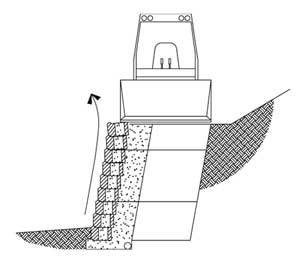
Localized Overturning
We have had a few projects where the walls have been constructed, but then they need to be relocated because of site or design changes. Because the blocks are modular mortarless units the contractors have been able to unstack the block and use them in the rebuild. This leads into the first consideration: Are the materials able to be reused or are they damaged or degraded to the point they have lost their structural integrity?
We have used the rebuild approach when we have localized overturning at the top of a retaining wall. This overturning could have resulted from heavy equipment operating too close to the wall, it could be due to runoff surface water, or it may be from a fence that was improperly installed. Where this localized failure has occurred, it is typically recommended that the area be restacked after the cause of the problem has been resolved.
Renew
The Ramapo Cirque project provided some insight as to when renewing a wall may be possible. Each site is unique, but here are a few things that need to be considered:
- Top of wall conditions limit excavation
- The existing timber wall is stable, but the timbers are just decaying
- Is the customer just looking for a different aesthetic finish?
These are common applications where a wall can be renewed. When excavation options are limited, alternate reinforcement options such as no-fines concrete, earth anchors, or even reusing geogrid reinforcement by connecting a new face to existing grid layers have been used.
Here is an example of a timber wall that was still structurally sound, but the property manager was concerned about future decay of the wooden structure. Because of the slope above, the engineer designed an earth anchor structure to tie back the Allan Block face. This next project called for building a new Allan Block wall directly in front of an existing modular block wall as the property owner wanted to revitalize the site. To minimize the distance between the units the engineer designed the wall using no-fines concrete between the units to connect the block walls together.
Replace
Wall replacement is typically reserved for when a wall fails or structural damage has occurred to the existing wall facing. Obviously, replacing could utilize some of the reinforcement options we have already covered, but a complete replacement will require additional space and open site conditions. Keep in mind that removal of the existing wall,along with over excavation for proper installation of the new wall is typically required.
While this is not typically done, for this project the contractor worked with the local engineer and removed the existing modular block from the face of the wall while keeping the geogrid layers intact. This way they could replace the block with Allan Block. Careful excavation was required so they did not damage the geogrid reinforcement. The engineer then inspected the reinforced soil before they started building the new Allan Block wall. The existing grid was then reinstalled within the appropriate courses of block as the new wall was constructed.
Obviously, every site has different conditions that will impact what path should be taken. However, the options discussed are just the tip of the iceberg when it comes to the possible solutions that can be utilized. Whether you rebuild, renew, or replace you can feel confident in your decision as long as you gather the appropriate information and consider all your options.






